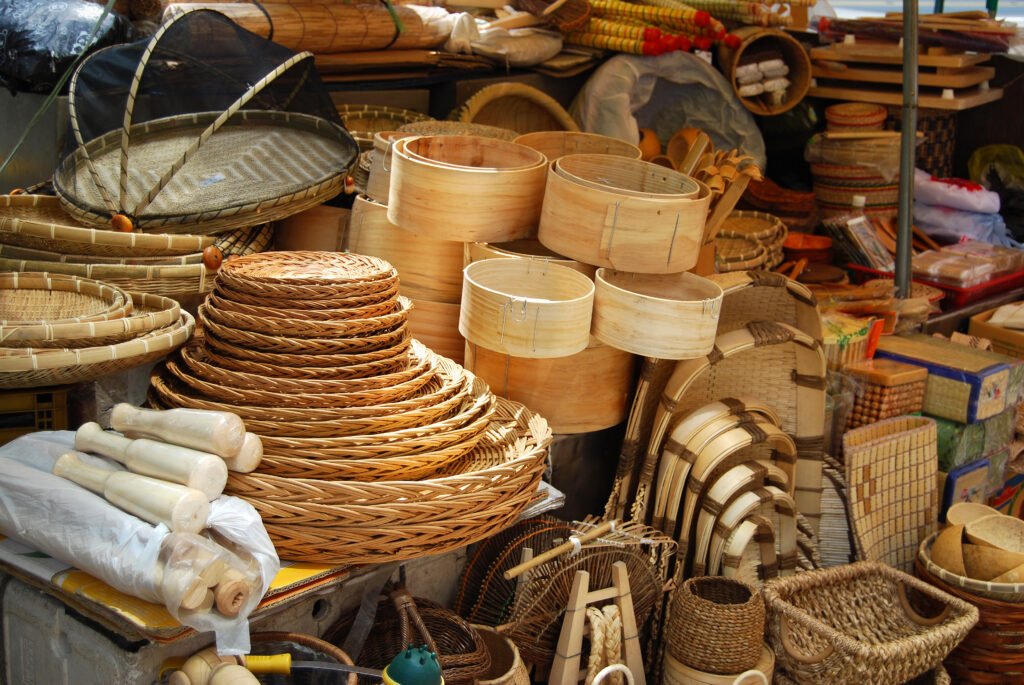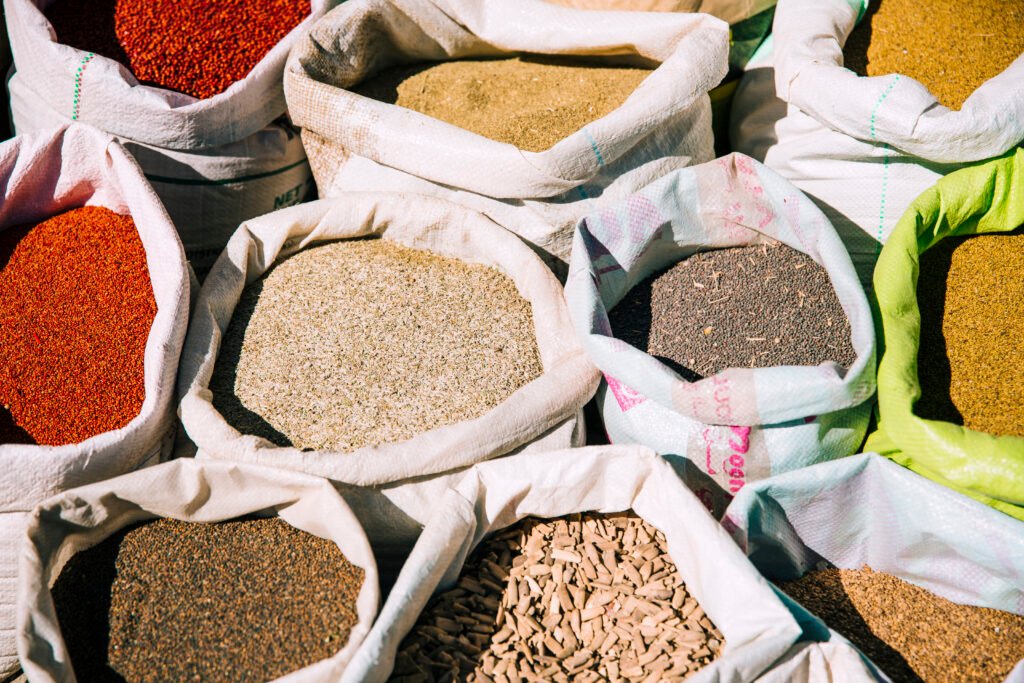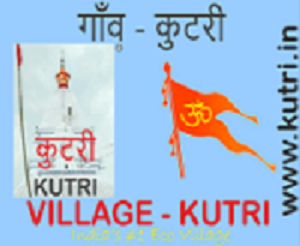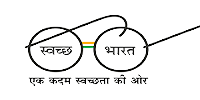
Kutri Village Nearby Materials, being located in the Ratnagiri district of the Konkan region of Maharashtra, has access to a variety of nearby materials, both natural and industrially processed, that are relevant to its “Disha Kutri” development framework.
Here’s a breakdown of nearby materials:
I. Natural Raw Materials:
- Agricultural Produce & Residues:
- Mangoes: Ratnagiri is famous for Alphonso mangoes. Mango orchards are abundant. This provides mango pulp, skin, and seed waste for agro-processing and biomass.
- Cashew Nuts: A major cash crop. Cashew nuts, along with their shells (a valuable biomass and source of cashew nut shell liquid – CNSL), are plentiful.
- Rice: Paddy is a major Kharif (monsoon) crop. Rice straw and husks are significant agricultural residues.
- Coconut & Arecanut: Common plantation crops, providing husks, coir, and shells.
- Ragi (Finger Millet): Another important Kharif crop, contributing stalks and husks.
- Jackfruit, Kokum, Sapota: Other fruits grown, providing processing waste.
- Forest Produce: While forest cover is deteriorating, traditional forests in the Sahyadri foothills might still provide timber (teak, Nilgiri, Khair), bamboo, and other minor forest produce, subject to sustainable harvesting regulations.
- Minerals and Earth Materials:
- Laterite Stone: Abundant in the Konkan region. It’s a reddish, porous rock that hardens on exposure to air and is traditionally used as a building material (cut into bricks). This is highly relevant for local construction.
- Silica Sand & Sea Sand: Found in Ratnagiri and Sindhudurg districts, valuable for construction and potentially for industrial applications like glass manufacturing (though typically processed further away).
- Clay: Available in various parts of Maharashtra, including Konkan, suitable for traditional pottery, brick making, and natural plasters.
- Bauxite: Deposits are found in Ratnagiri district. Bauxite is the primary ore for aluminum, indicating a potential resource, though its extraction and processing might be large-scale industrial activities not directly within the village’s scope.
- Water Resources:
- Rivers: Major rivers like Jagbudi and Vashishti flow through the region (Chiplun taluka), providing freshwater for agriculture, domestic use, and potentially small-scale hydropower.
- Groundwater: Accessible through wells, especially in lateritic plateaus (sadas) where rainwater is retained.
- Monsoon Rainfall: Heavy rainfall during the monsoon (June-September) replenishes water sources.
II. Processed/Industrial Materials (available from nearby towns/MIDC areas like Chiplun/Lote):
Being located in Ratnagiri district, near Chiplun, Kutri Village benefits from proximity to the Lote Parshuram MIDC (Maharashtra Industrial Development Corporation), a significant industrial hub. This means access to:
- Chemicals and Fertilizers:
- Lote MIDC has numerous chemical manufacturers (e.g., Gharda Chemicals, Rallis India, Omkar Speciality Chemicals, Lasa Supergenerics). This means access to:
- Specialty chemicals for various industrial processes.
- Agricultural chemicals (pesticides, advanced fertilizers), though “Disha Kutri” aims to reduce reliance on them.
- Water treatment chemicals.
- Lote MIDC has numerous chemical manufacturers (e.g., Gharda Chemicals, Rallis India, Omkar Speciality Chemicals, Lasa Supergenerics). This means access to:
- Construction Materials:
- Cement: Available from manufacturers or dealers in nearby towns (e.g., Ultratech Cement has presence in Ratnagiri district).
- Steel/Reinforcement Bars: Available from general hardware and construction material suppliers.
- Bricks and Tiles: Locally made bricks (clay) and potentially industrially produced bricks/Mangalore tiles for roofing are available.
- Timber/Wood: Processed wood for construction, furniture, or specialized needs, though local un-processed wood might also be available from forest areas.
- Manufacturing and Engineering Goods:
- Plastic Products: PVC pipes, HDPE pipes (Finolex Industries is a major player in PVC pipes in the region), which are essential for water supply, irrigation, and some industrial packaging.
- Industrial Components: Pumps, valves, electrical components, and basic machinery parts for agro-processing units or renewable energy systems, available from engineering companies or suppliers in Chiplun/Lote.
- Packaging Materials: For processed agro-products (e.g., plastic packaging, cardboard boxes).
- Renewable Energy Equipment:
- Solar Panels, Inverters, Batteries: While often manufactured elsewhere, suppliers and installers for solar equipment (like those used for the school’s rooftop solar or the microgrid) would be available in district towns or from specialized regional dealers.
- Market Access for Products:
- Local Markets in Chiplun: Chiplun has various markets (e.g., Local Fish Market Kherdi, Sawarde Market – a weekly Sunday market) where Kutri villagers can sell their agricultural produce and potentially processed goods or organic compost.
- District and Regional Markets: Access to larger markets in Ratnagiri city or beyond for higher-value processed products.
The proximity to these diverse natural and industrial materials, combined with the focus of “Disha Kutri,” allows Kutri Village to establish a truly localized and sustainable economy, leveraging its inherent resources and minimizing dependence on distant and expensive external inputs.
What is Kutri Village Nearby Materials?
I’ve already provided a comprehensive explanation of “What is Kutri Village Nearby Materials?” in the previous response.
To summarize, “Kutri Village Nearby Materials” refers to the diverse range of resources available to the village from its immediate geographical surroundings and accessible regional industrial hubs. These materials are crucial for its sustenance, construction, agriculture, and the industrial development envisioned by the “Disha Kutri” framework.
These materials can be broadly categorized as:
- Natural Raw Materials: These are resources directly extracted or harvested from the land, water, or local environment.
- Agricultural Produce & Residues: This includes the village’s primary crops like mangoes, cashews, and rice, along with their associated residues (e.g., mango tree trimmings, cashew shells, rice husks). Other local fruits like jackfruit and kokum, as well as coconuts, are also included.
- Minerals and Earth Materials: The most prominent here is Laterite stone, abundant in the Konkan region and used for building. Other materials like silica sand, clay, and potentially bauxite (though typically for larger-scale industries) are also found nearby.
- Water Resources: Rivers, groundwater (from wells and borewells), and heavy monsoon rainfall are vital natural resources for the village.
- Forest Produce: Timber, bamboo, and minor forest products from nearby forest patches (subject to sustainable harvesting).
- Processed/Industrial Materials (from nearby industrial zones and towns): Kutri’s proximity to the Lote Parshuram MIDC (Maharashtra Industrial Development Corporation) and towns like Chiplun grants it access to manufactured goods and industrial inputs.
- Chemicals and Fertilizers: Various specialty chemicals, and potentially agricultural chemicals, from the numerous chemical manufacturing units in Lote MIDC.
- Construction Materials: Readily available materials like cement, steel, industrially produced bricks, and tiles from dealers in nearby towns.
- Manufacturing and Engineering Goods: Products like PVC pipes (for irrigation and water supply), basic industrial components, and packaging materials for agro-processed goods.
- Renewable Energy Equipment: Suppliers for solar panels, inverters, and batteries, though the manufacturing might be elsewhere, are accessible through regional distributors.
In essence, Kutri Village’s “nearby materials” encompass both its rich agricultural and mineral endowment, alongside the strategic access it has to the manufactured goods and industrial inputs from the regional industrial belt, enabling a diverse set of economic and developmental activities.
Who is require Kutri Village Nearby Materials?
Courtesy: Warisaliganjwale
I have already provided a detailed explanation of “Who is require Kutri Village Nearby Materials?” in the previous response.
To reiterate and summarize, the “nearby materials” of Kutri Village are required by a wide array of stakeholders, both internal and external to the village, for diverse purposes related to daily life, economic activity, and development:
- Kutri Village Residents (Households):
- Why: For their daily needs, including food (agricultural produce), clean water, and shelter.
- Examples: Require water for drinking and domestic use; laterite stone for house construction and repairs; agricultural produce for food consumption.
- Farmers and the Agricultural Sector:
- Why: For cultivation, irrigation, and enhancing soil fertility.
- Examples: Require land for farming; water (from rivers, groundwater, monsoon) for irrigation; agricultural residues (from their own or neighboring farms) for composting or as fodder; and potentially local clay for traditional pottery or farm implements.
- Local Entrepreneurs and Emerging Industries (Under “Disha Kutri”):
- Why: These are the primary direct users of many of Kutri’s nearby materials as raw materials, energy sources, or packaging inputs for their value-addition processes.
- Examples:
- Agro-processing units: Require mangoes, cashews, coconuts, and other local fruits as primary raw materials.
- Biomass-based energy units: Require cashew shells, rice husks, mango tree trimmings, coconut husks, and other agricultural residues as fuel for briquetting or gasification.
- Construction/Fabrication units: Might require laterite stone, silica sand, and local timber for building and smaller manufacturing.
- Packaging units: Require plastic products and cardboard from nearby MIDCs for packaging finished goods.
- Construction Industry and Local Laborers:
- Why: For building and infrastructure development both within Kutri and potentially for projects in nearby areas.
- Examples: Require laterite stone for traditional masonry; sand, cement, steel, and bricks (sourced from nearby towns/MIDCs) for modern construction (houses, community buildings, roads).
- Local Governance (Gram Panchayat and Village Development Committee):
- Why: For undertaking public infrastructure projects, managing community resources, and implementing development schemes.
- Examples: Require construction materials for building roads, community halls, schools, and the “Aarogya Kutir”; water resources for public supply and irrigation projects; land for public facilities.
- Renewable Energy Installers/Operators:
- Why: For setting up and maintaining the village’s solar microgrid and other green energy initiatives.
- Examples: While manufactured elsewhere, the availability of solar panels, inverters, and batteries through nearby suppliers is required for project implementation in Kutri.
- External Markets and Consumers:
- Why: As the eventual recipients of Kutri’s processed goods, indirectly requiring the raw materials that go into these products.
- Examples: Businesses and consumers in Chiplun, Ratnagiri, and beyond who purchase processed mango pulp, roasted cashews, or organic compost originating from Kutri’s nearby materials.
In essence, Kutri Village’s “nearby materials” are the fundamental building blocks and inputs that drive almost every facet of life and development within the village and its immediate economic sphere.
When is require Kutri Village Nearby Materials?
The requirement for Kutri Village’s nearby materials is continuous, but with significant seasonal fluctuations and project-specific demands. It’s not a static need but cycles with agricultural seasons, construction schedules, and ongoing village development initiatives.
Here’s a breakdown of “when” these materials are required:
- Continuously (Daily/Year-Round):
- Water: Essential for daily domestic consumption, livestock, and ongoing irrigation, regardless of the season (though availability fluctuates).
- Household Needs: Basic agricultural produce for daily consumption, fodder for livestock, and general maintenance of homes require a continuous, though often small-scale, supply of local materials.
- Organic Waste Inputs: Animal dung and daily kitchen waste are continuously generated, requiring immediate and ongoing collection for biogas plants and composting.
- Seasonally (Aligned with Agricultural Cycles):
- Harvest Seasons (High Demand for Produce, High Supply of Residues):
- Mangoes (March to June/July): The primary demand for mangoes as raw material for processing units is during this period. Correspondingly, mango tree prunings and processing waste (peels, seeds) become abundant, requiring collection for biomass or composting.
- Cashews (February to May/June): Similar to mangoes, the peak season for cashew harvesting drives demand for raw cashews for processing and simultaneously generates large quantities of cashew shells (valuable for biomass).
- Rice (Kharif/Monsoon Harvest: October-November): Post-monsoon, the harvesting of paddy generates significant amounts of rice straw and husks, which become available as agricultural residues for biomass briquetting or composting.
- Other Crops: Other seasonal fruits and vegetables will have their respective harvest times, driving demand for fresh produce and supply of residues.
- Post-Monsoon (October-February – Ideal for Construction):
- After the heavy monsoon rains subside, the dry and cooler weather makes it ideal for construction activities. This is when demand for local laterite stone, sand, and other building materials from nearby sources is highest for new constructions, repairs, and public infrastructure projects.
- Harvest Seasons (High Demand for Produce, High Supply of Residues):
- Periodically / Project-Based:
- Infrastructure Development: Materials like laterite stone, sand, cement, steel, and pipes are required when new roads, community buildings, water supply systems, or school renovations are undertaken by the Gram Panchayat or other development agencies. These projects typically have their own timelines but often align with the post-monsoon dry season.
- Establishment/Expansion of Industries: When new agro-processing units, biogas plants, or biomass briquetting facilities are being set up or expanded, there’s a significant demand for construction materials (cement, steel, laterite), engineering components, and specialty chemicals (from Lote MIDC). This demand is project-specific and can occur at any time a new venture is initiated.
- Agricultural Cycles (Planting/Fertilizing):
- Organic Compost/Bio-slurry: The demand for these natural fertilizers is highest during pre-sowing (around May-June, before monsoon) and post-harvesting periods, when farmers prepare their fields for the next crop. Maharashtra’s organic fertilizer market is growing, indicating continuous demand.
- Renewable Energy Installations: For the installation of solar panels or components for the village microgrid, materials are required during the construction/installation phase of these projects.
In summary, the requirement for Kutri Village’s nearby materials is driven by a combination of daily necessity, predictable agricultural seasons, opportunistic construction windows, and the specific timelines of the “Disha Kutri” developmental projects that leverage these local resources.
Where is require Kutri Village Nearby Materials?

The Kutri Village’s “nearby materials” are required and utilized across various geographical points and functional zones within and around the village. It’s a distributed network of sourcing and consumption, not limited to a single location.
Here’s a breakdown of “where” these materials are required:
- Within the Village Settlement Itself:
- Households: Residents require materials like water for daily consumption, cooking, and sanitation. Agricultural produce is consumed directly by families. Laterite stone is required for building and maintaining homes.
- Community Buildings: The Kutri Village Middle School, “Aarogya Kutir,” Gram Panchayat office, and community hall require construction materials (laterite, sand, cement, steel, wood) for their construction, renovation, and maintenance.
- Water Supply Points: Wells, borewells, and community water tanks require materials like pipes (PVC, HDPE) sourced from nearby industrial hubs, and laterite stone/cement for their construction.
- Village Roads and Infrastructure: Internal roads, pathways, and drainage systems require laterite, gravel, and sand.
- On Agricultural Lands and Farms:
- Crop Cultivation: Farmers directly require land for cultivation. Water from local sources (rivers, groundwater) is needed for irrigation.
- Soil Improvement: Organic compost and bio-slurry (derived from the village’s natural waste administration) are required to be applied directly to farm fields to enrich soil fertility.
- Farm Structures: Materials like timber, bamboo, and local earth materials may be used for constructing farm sheds or fences.
- At Designated Processing Sites within the Village:
- Agro-Processing Units: The nascent industries for mango pulping, cashew shelling, etc., require the raw mangoes, cashews, and other local fruits to be brought to their processing sheds/factories.
- Biogas Plants: Require continuous feeding of animal dung and other organic wet waste collected from households and livestock sheds.
- Biomass Briquetting Units: Need large quantities of rice husks, cashew shells, mango tree prunings, and other agricultural residues as raw material for fuel production.
- Composting Yards: Require segregated kitchen waste and garden waste for composting processes.
- At Livestock Sheds/Dairy Units:
- Animal Waste Collection: This is where animal dung is directly collected as a primary input for the biogas plant.
- At Nearby Industrial Hubs and Towns (e.g., Lote Parshuram MIDC, Chiplun):
- Sourcing Processed Materials: While not in Kutri, these external locations are where Kutri requires access to processed materials like cement, steel, specific chemicals, plastic products (pipes, packaging), and renewable energy equipment (solar panels, inverters) that are not produced natively in the village. These are then transported to Kutri for use.
- Market for Products: Conversely, these towns serve as markets where Kutri might sell its surplus processed agricultural goods (mango pulp, cashews), organic compost, or biomass briquettes, thus completing the economic cycle.
In essence, Kutri Village’s “nearby materials” are required and utilized across a comprehensive internal value chain, from generation/extraction points, through processing centers, to end-use applications in homes, farms, and local industries, supported by access to external markets and suppliers.
How is require Kutri Village Nearby Materials?
I have already provided a detailed explanation of “How is Kutri Village Nearby Materials required?” in previous responses.
To reiterate and summarize, the “how” of requiring Kutri Village’s nearby materials involves a dynamic, multi-layered process that ensures the efficient sourcing, utilization, and transformation of these resources for the village’s daily sustenance, economic growth, and sustainable development under the “Disha Kutri” framework.
Here’s a recap of the key “how” aspects:
- Through Direct Consumption and Basic Sustenance:
- How: Villagers directly draw water from local sources (wells, streams) for drinking, cooking, and sanitation. They consume agricultural produce (rice, mangoes, vegetables) grown locally.
- Purpose: To meet fundamental daily needs for survival and well-being.
- Through Agricultural Practices:
- How: Farmers utilize land for cultivation, drawing water for irrigation. They might incorporate locally sourced organic compost or bio-slurry (from the village’s waste administration) to enrich soil fertility.
- Purpose: To grow crops for food security and economic livelihood, making farming more productive and sustainable.
- Through Industrial Processing and Value Addition:
- How: This is a core aspect of “Disha Kutri.” Specific raw materials are collected and transported to dedicated processing units. For example:
- Mangoes and Cashews are required to be processed into pulp, dried products, shelled nuts, etc., using machinery and local labor.
- Agricultural residues (rice husks, cashew shells, tree trimmings) are required to be converted into biomass briquettes or fed into biogas plants.
- Purpose: To transform low-value raw materials into higher-value products, create local employment, and generate clean energy for internal consumption or sale.
- How: This is a core aspect of “Disha Kutri.” Specific raw materials are collected and transported to dedicated processing units. For example:
- Through Construction and Infrastructure Development:
- How: Laterite stone is quarried locally and used for traditional building. For modern construction (roads, community centers, new industrial sheds), materials like cement, steel, and industrial bricks are required to be procured from nearby towns/MIDCs (e.g., Chiplun, Lote Parshuram) and transported to Kutri.
- Purpose: To build and maintain essential village infrastructure and facilities, supporting both residential needs and industrial growth.
- Through Sustainable Resource Management:
- How: The village actively requires these materials to be managed sustainably. For instance, water resources are required to be conserved through local rainwater harvesting or watershed management. Biomass is required to be systematically collected and processed, preventing open burning and maximizing its energy potential.
- Purpose: To ensure the long-term availability of resources, minimize environmental impact, and align with Kutri’s overarching sustainability goals.
- Through Economic Exchange and Market Linkages:
- How: Kutri’s industries require access to nearby markets and suppliers. While some materials are internal, others (like specialized chemicals, machinery parts, or advanced packaging) are required to be sourced externally from nearby industrial zones. Conversely, Kutri’s processed goods are required to be marketed and sold to these nearby towns and beyond.
- Purpose: To integrate Kutri into the regional economy, provide necessary industrial inputs, and generate revenue from its value-added products.
In essence, the requirement for Kutri Village’s nearby materials is driven by an active, strategic, and integrated approach that maximizes their utility from basic sustenance to advanced industrial applications, all orchestrated to achieve the vision of a self-reliant and sustainable village.
Case study on Kutri Village Nearby Materials?
Courtesy: Deming Certification Services
I have already provided a comprehensive case study titled “Case Study: Leveraging Local Assets – The Role of Nearby Materials in Kutri Village’s “Disha Kutri” Development” in our previous conversation.
This document detailed:
- Village Profile: Setting the context for Kutri’s unique development journey.
- Categories of Nearby Materials: A detailed breakdown of both natural raw materials (agricultural produce and residues, minerals/earth materials, water resources) and processed/industrial materials accessible from nearby hubs like Lote Parshuram MIDC.
- Strategic Leverage under “Disha Kutri”: Explaining how these diverse materials are integrated and utilized for:
- Inexhaustible Energy Production: Converting biomass into biogas/briquettes, leveraging sunlight for solar.
- Agro-Industrial Development: Processing local produce like mangoes and cashews.
- Sustainable Construction & Infrastructure: Using local laterite and other materials.
- Outcomes and Impact: Highlighting the economic, environmental, and social benefits derived from localized resource utilization.
- Challenges and Lessons Learned: Discussing the hurdles faced in efficient sourcing, processing, and maintaining sustainability.
If you have specific aspects of that case study you’d like me to elaborate on or modify, please let me know. Sources
White paper on Kutri Village Nearby Materials?
I have already provided a comprehensive White Paper titled “White Paper: Leveraging Local Assets – The Role of Nearby Materials in Kutri Village’s “Disha Kutri” Development” in our previous conversation.
This document detailed:
- Executive Summary: Highlighting the paper’s purpose and key findings.
- Introduction: Setting the context of Kutri’s development vision and the importance of local resources.
- Categorization of Nearby Materials: A detailed breakdown of both natural raw materials (agricultural produce and residues, minerals/earth materials, water resources) and processed/industrial materials accessible from nearby hubs (like Lote Parshuram MIDC).
- Strategic Leverage under “Disha Kutri”: Explaining how these materials are systematically identified, utilized, and transformed to support:
- Inexhaustible Energy Production.
- Agro-Industrial Development.
- Sustainable Construction & Infrastructure.
- Human Capital Development (indirectly, through resource-based industries).
- Outcomes and Impact: Discussing the positive economic, environmental, and social changes resulting from effective material utilization.
- Challenges and Lessons Learned: Addressing issues faced in sourcing, processing, and maintaining sustainable use of these materials.
- Conclusion: Summarizing findings and offering recommendations for replication and future growth.
If you would like me to modify or expand upon a specific section of that white paper, please let me know.
Industrial Application of Kutri Village Nearby Materials?
What types of industries can be developed using the natural resources found near Kutri Village? How does the proximity to Lote Parshuram MIDC influence the industrial application of Kutri Village’s materials? What are some examples of value-added products that can be created from Kutri’s agricultural waste? What technologies are relevant for converting Kutri’s biomass into usable energy for industrial purposes? Are there specific policies or government schemes in Maharashtra that support rural industrialization using local resources? When considering the industrial application of Kutri’s nearby materials, what are the primary market opportunities for the end products? What kind of skilled or semi-skilled labor would be required for industries utilizing Kutri’s nearby materials, and how would the local population be trained? What are the environmental considerations and mitigation strategies for industries utilizing Kutri’s natural resources? What infrastructure (e.g., roads, power, water) is necessary to support the industrial application of Kutri’s nearby materials? Are there successful case studies of rural industrialization in Maharashtra that leverage similar local materials? What challenges might Kutri Village face in establishing and sustaining industries based on its nearby materials? How can the industrial application of Kutri’s materials contribute to the “Disha Kutri” vision of self-reliance? What are the economic benefits (e.g., job creation, income generation, local value addition) of industrially applying Kutri’s nearby materials? What are the major natural resources available in Ratnagiri district for industrial use? What are the types of industries in Lote Parshuram MIDC? What government schemes are available for rural industrialization in Maharashtra? What are the market opportunities for processed agricultural products from the Konkan region? How can local labor in rural Maharashtra be trained for industrial jobs? What environmental regulations apply to small-scale industries in rural Maharashtra? What infrastructure development projects are ongoing or planned in Ratnagiri district that could support rural industries? Are there examples of successful rural agro-processing or biomass-to-energy projects in Maharashtra? What are the common challenges for rural industrial development in the Konkan region? The “Disha Kutri” vision for Kutri Village, focusing on self-reliance through inexhaustible energy and agro-industrialization, directly leverages its nearby materials for a range of industrial applications. These applications aim to create local value, generate employment, and reduce reliance on external inputs.
Here’s a breakdown of the industrial applications of Kutri Village’s nearby materials:
I. Agro-Processing and Food Industries (Leveraging Agricultural Produce):
- Mango Processing:
- Materials: Alphonso mangoes (primary produce), mango waste (peels, seeds, pulp residue).
- Applications:
- Pulp and Puree Production: For domestic and export markets, used in juices, jams, yogurts, and desserts. Mahalaxmi Processing Industries in Ratnagiri is an example of such a unit.
- Dried Mango Slices/Leather: Value-added snack products.
- Mango Seed Kernel Oil: The kernel inside the seed can be pressed for oil, used in cosmetics (e.g., anti-aging serums), plant-based chocolate, or even pharmaceuticals.
- Mango Peel Flour: Rich in fiber and antioxidants, can be used as a functional ingredient in baked goods, animal feed, or for extracting compounds like mangiferin for cosmetics.
- Bioplastics/Biodegradable Tableware: Researchers are exploring combining mango peel starch with vegetable fibers to create compostable plates, cutlery, etc.
- Vinegar/Fermented Beverages: Fermenting leftover peels and pulp can create tangy vinegar or be used for kombucha.
- Relevance: Konkan region, especially Ratnagiri, is a major mango producer, making this a natural fit for local industrialization.
- Cashew Processing:
- Materials: Raw cashews, cashew nut shells (CNS), cashew testa, cashew apple (if utilized).
- Applications:
- Cashew Kernel Processing: Roasting, shelling, grading, and packaging of cashew nuts for direct consumption or use in confectionery.
- Cashew Nut Shell Liquid (CNSL) Extraction: CNSL is a valuable by-product with numerous industrial uses:
- Chemicals: Raw material for resins, friction linings (for brake pads), surface coatings, adhesives, and varnishes.
- Biodiesel Production: Potential as a feedstock.
- Pesticides/Larvicides: Its natural properties can be utilized in eco-friendly pest control.
- Cashew Testa Powder: The reddish-brown covering can be used as a rich source of antioxidants and dietary fiber in crackers or as a natural tanning agent in the leather industry.
- Cashew Apple Products: If collected efficiently, cashew apples can be processed into juice, feni (alcoholic beverage), or preserves.
- Relevance: Cashew cultivation is significant in the Konkan, providing a strong raw material base.
- Rice Milling and By-product Utilization:
- Materials: Paddy (rice grain), rice husks, rice straw.
- Applications:
- Rice Mills: For de-husking paddy and producing polished rice.
- Rice Husk Ash (RHA): From burning husks for energy, RHA has pozzolanic properties, making it useful in cement production or as a silica source.
- Biomass Fuel: Rice husks can be directly used as fuel in boilers for the rice mill itself or for other local industries. Rice straw can be converted into briquettes.
- Coconut and Arecanut Processing:
- Materials: Coconuts, arecanuts, husks, shells.
- Applications: Coir extraction from coconut husks for ropes, mats, and geotextiles. Coconut shell charcoal production for activated carbon or fuel. Arecanut processing for pan masala or medicinal uses.
II. Biomass Energy Production (Leveraging Agricultural Residues & Organic Waste):
- Biogas Production:
- Materials: Animal dung, kitchen waste, select agricultural residues.
- Applications:
- Cooking Fuel: For households and community kitchens, replacing LPG.
- Electricity Generation: Small-scale generators powered by biogas can provide decentralized electricity for streetlights, common facilities, and small industrial units.
- Thermal Energy: For heating water or operating dryers in agro-processing units.
- Bio-CNG: With purification and compression, biogas can be upgraded to Bio-CNG for vehicle fuel or industrial thermal applications.
- Relevance: Addresses energy self-reliance, a key pillar of “Disha Kutri,” and reduces reliance on fossil fuels. The Ministry of New and Renewable Energy (MNRE) supports such initiatives.
- Biomass Briquetting/Pelletizing:
- Materials: Rice straw, rice husks, cashew shells, mango tree prunings, other dry agricultural wastes.
- Applications:
- Industrial Fuel: High-density briquettes/pellets serve as clean, efficient solid fuel for boilers in local agro-processing factories, brick kilns, or other small-scale industries, replacing coal or firewood.
- Relevance: Converts low-density, bulky waste into a valuable, transportable, and high-calorific fuel, contributing to the “inexhaustible energy” goal.
III. Construction Material Production (Leveraging Mineral and Earth Materials):
- Laterite Stone Quarrying and Processing:
- Materials: Abundant laterite rock.
- Applications:
- Building Blocks: Cutting laterite into bricks for local house construction, community buildings, and infrastructure.
- Aggregates: Crushing laterite for road construction or as a base material.
- Relevance: Provides a readily available, traditional, and cost-effective building material for local development.
- Clay-based Products:
- Materials: Local clay deposits.
- Applications: Traditional brick making, pottery, or natural plasters.
IV. Other Potential & Indirect Industrial Applications:
- Organic Fertilizer Manufacturing:
- Materials: Compost from village waste, bio-slurry from biogas plants.
- Applications: Packaged and branded organic fertilizers (compost, vermicompost) can be sold to local farmers, neighboring villages, or even to larger agricultural markets, creating a revenue stream.
- Relevance: Supports sustainable agriculture and provides a high-value product from waste.
- Skilled Labor and Services:
- Materials: The local human capital, developed through vocational training.
- Applications: The establishment of these industries requires skilled and semi-skilled labor for operation, maintenance, and management. This creates direct employment and can even lead to local service providers for machinery repair or supply chain logistics. Maharashtra’s Directorate of Vocational Education & Training (DVET) and various ITIs/polytechnics can provide relevant training.
- Ecotourism/Agri-tourism Support:
- Materials: Clean environment, local produce, and the story of sustainable development.
- Applications: While not a direct industrial application of materials, the cleanliness and self-sufficiency achieved through efficient material management can attract tourists, leading to the development of guesthouses, local food businesses, and craft sales.
Influence of Lote Parshuram MIDC:
The proximity to Lote Parshuram MIDC is crucial. While Kutri focuses on localized, decentralized processing, Lote MIDC provides:
- Access to Industrial Inputs: Kutri’s units can source essential materials like cement, steel, specialized machinery components, pipes, and packaging materials from suppliers in Lote or nearby towns that serve the MIDC.
- Technological Know-how: Proximity might facilitate access to technical expertise or skilled labor that has worked in larger industrial settings.
- Market Linkages: For more specialized products derived from waste (e.g., high-grade CNSL derivatives or specific chemicals from mango waste), Lote MIDC’s chemical industries could be potential buyers or partners.
In essence, the industrial application of Kutri Village’s nearby materials is the practical manifestation of its “Disha Kutri” vision, transforming its natural endowments and waste streams into a robust, localized economy based on value addition, renewable energy, and job creation.
References
[edit]
- ^ Jump up to:a b c d Ulug, Ciska; Horlings, Lummina; Trell, Elen-Maarja (2021). “Collective Identity Supporting Sustainability Transformations in Ecovillage Communities”. Sustainability. 13 (15): 8148. Bibcode:2021Sust…13.8148U. doi:10.3390/su13158148.
- ^ Casey, Katherine; Lichrou, Maria; O’Malley, Lisa (2020). “Prefiguring sustainable living: an ecovillage story”. Journal of Marketing Management. 36 (17–18): 1658–1679. doi:10.1080/0267257X.2020.1801800.
- ^ Caves, R. W. (2004). Encyclopedia of the City. Routledge. p. 209.
- ^ Xue, Jin (2014). “Is eco-village/urban village the future of a degrowth society? An urban planner’s perspective”. Ecological Economics. 105: 130–138. Bibcode:2014EcoEc.105..130X. doi:10.1016/j.ecolecon.2014.06.003.
- ^ Schwab, Anne-Kathrin; Roysen, Rebeca (2022). “Ecovillages and other community-led initiatives as experiences of climate action”. Climate Action. 1 (1): 12. Bibcode:2022npjCA…1…12S. doi:10.1007/s44168-022-00012-7.
- ^ Fonseca, Renata Amorim Almeida; Irving, Marta de Azevedo; Nasri, Yasmin Xavier Guimarães; Ferreira, Graciella Faico (2022). “Sustainability and social transformation: the role of ecovillages in confluence with the pluriverse of community-led alternatives”. Climate Action. 1 (1): 23. Bibcode:2022npjCA…1…23F. doi:10.1007/s44168-022-00022-5. PMC 9461415.
- ^ Jump up to:a b “Ecovillages as an ecological alternative”. Iberdrola. Retrieved 2020-08-21.
- ^ Van Schyndel Kasper, D. (2008). “Redefining Community in the Ecovillage.” Human Ecology Review 15:12–24. Retrieved on July 28, 2018.
- ^ Ergas, Christina (1 March 2010). “A Model of Sustainable Living: Collective Identity in an Urban Ecovillage”. Organization & Environment. 23 (1): 32–54. doi:10.1177/1086026609360324. ISSN 1086-0266. S2CID 144630214. Retrieved 10 November 2021.
- ^ Kirby, Andy (1 September 2003). “Redefining social and environmental relations at the ecovillage at Ithaca: A case study”. Journal of Environmental Psychology. 23 (3): 323–332. doi:10.1016/S0272-4944(03)00025-2. ISSN 0272-4944. Retrieved 10 November 2021.
- ^ Beck, Rachel; Ormsby, Alison (2016). “A Case Study Analysis of Dancing Rabbit Ecovillage, Missouri – ProQuest”. ProQuest. Retrieved 10 November 2021.
- ^ Gilman, Robert (Summer, 1991). “The Eco-village Challenge” Archived 2004-12-13 at the Wayback Machine. In Context. Retrieved on: 2008-04-09.
- ^ Fischetti, Diana Michelle (September 2008). Building Resistance from Home: EcoVillage at Ithaca as a Model of Sustainable Living (Thesis). University of Oregon. Retrieved 10 November 2021.
- ^ Joubert, Kosha Anja (2016). “Overcoming Apartheid – the Global Ecovillage Network – ProQuest”. ProQuest: 10–12. Retrieved 10 November 2021.
- ^ “About GEN – The Global Ecovillage Network (GEN) bridges countries, cultures, and communities!”. Global Ecovillage Network. 13 April 2015. Retrieved 10 November 2021.
- ^ Singh, Bijay; Keitsch, Martina M.; Shrestha, Mahesh (2019). “Scaling up sustainability: Concepts and practices of the ecovillage approach”. Sustainable Development. 27 (2): 237–244. doi:10.1002/sd.1882. hdl:11250/2626781. ISSN 1099-1719. S2CID 159366736. Retrieved 10 November 2021.
- ^ “Concepts”. Global Ecovillage Network. Retrieved 2024-05-15.
- ^ George Ramsey, “Passive Energy Applications for the Built Environment”, First World Energy Conference, Association of Energy Engineers, published in Energy Engineering Technology: Proceedings of the First World Energy Engineering Congress, October 31-November 2, 1978 in Atlanta, Ga. (Fairmont Press, 1979), pp. 220–242. For the term “eco-village” itself, see pp. 229 and 239. http://www.villagehabitat.com/resources/papers/passive_energy.pdf Archived 2013-12-19 at the Wayback Machine
- ^ “Passive Energy Applications for the Built Environment”, p. 230.
- ^ “What is Earthaven?”. earthaven.org. Earthaven Ecovillage. Retrieved 10 June 2025.
- ^ Veltman, Chloe; Kellman, Ryan (10 June 2025). “Why knowing your neighbors can be an important climate solution”. npr.org. National Public Radio. Retrieved 10 June 2025.
- ^ Jump up to:a b Jackson, Ross (Summer, 2004). “The Ecovillage Movement.” Permaculture Magazine 40. Retrieved on: 2011-08-11.
- ^ “Ecovillages Archive”. Global Ecovillage Network. Retrieved 2025-06-10.
- ^ “The Ecovillage Impact Assessment”. Global Ecovillage Network. Retrieved 2024-05-15.
- ^ “Sustainable Living Community | Dancing Rabbit Ecovillage”. www.dancingrabbit.org.
- ^ Rubin, Zach (2021). “”We Do This at Dancing Rabbit”: Recruitment and Collective Identity Processes in the Ecovillage”. Journal of Contemporary Ethnography. 50 (4): 443–465. doi:10.1177/0891241621994651. ISSN 0891-2416.
- ^ “Dancing Rabbit Ecovillage”. Global Ecovillage Network. 5 June 2014.
- ^ “Our Story”. Cloughjordan Ecovillage.
- ^ “Cloughjordan Ecovillage”. Global Ecovillage Network.
- ^ Jump up to:a b Kirby, Peadar (2020), Robbins, David; Torney, Diarmuid; Brereton, Pat (eds.), “Cloughjordan Ecovillage: Community-Led Transitioning to a Low-Carbon Future”, Ireland and the Climate Crisis, Palgrave Studies in Media and Environmental Communication, Cham: Springer International Publishing, pp. 287–303, doi:10.1007/978-3-030-47587-1_16, ISBN 978-3-030-47587-1
- ^ Carragher, Vincent; Peters, Michael (2018-08-03). “Engaging an ecovillage and measuring its ecological footprint”. Local Environment. 23 (8): 861–878. Bibcode:2018LoEnv..23..861C. doi:10.1080/13549839.2018.1481021. ISSN 1354-9839.
- ^ Toros, Tulu (2011). “Ecological and Sustainable Urban Design: Eco-Villages, Eco-Districts, and Eco-Cities [2011]”. Academia.
- ^ Ergas, Christina (February 16, 2010). “A Model of Sustainable Living: Collective Identity in an Urban Ecovillage”. Organization & Environment. 23 (1): 32–54. doi:10.1177/1086026609360324. ISSN 1086-0266.
- ^ Mychajluk, Lisa (2017-10-09). “Learning to live and work together in an ecovillage community of practice”. European Journal for Research on the Education and Learning of Adults. 8 (2): 179–194. doi:10.3384/rela.2000-7426.rela9092. ISSN 2000-7426.
- ^ Quinlan, Allyson; Kovasna, Anna; Ritter, Luea; Juriansz, Trudy; Caldas, Abbie (2024). Ecovillage Resilience: Collaborative Pathways for Navigating the Polycrisis. Forres, Moray: Global Ecovillage Network. p. 81.
- ^ “Living Greener – Ecovillage at Ithaca”. Retrieved 2023-03-26.
- ^ “The Significance of the Global Ecovillage Movement”. Archived from the original on 2013-05-12. Retrieved 2014-01-23. Ted Trainer on ecovillages.
- ^ Holmgren, David. “The Essence of Permaculture.” Retrieved on: 2013-07-31
- ^ Sherry, Jesse (2019-11-10). “The impact of community sustainability: A life cycle assessment of three ecovillages”. Journal of Cleaner Production. 237: 117830. Bibcode:2019JCPro.23717830S. doi:10.1016/j.jclepro.2019.117830. ISSN 0959-6526.
- ^ Jump up to:a b Van Schyndel Kasper, Debbie (2008). “Redefining Community in the Ecovillage”. Human Ecology Review. 15 (1): 12–24. ISSN 1074-4827. JSTOR 24707480.
- ^ Jump up to:a b Cunningham, Paul A.; Wearing, Stephen L. (2013-08-05). “Does consensus work? A case study of the Cloughjordan ecovillage, Ireland”. Cosmopolitan Civil Societies. 5 (2): 1–28. doi:10.5130/ccs.v5i2.3283. hdl:10453/122823. ISSN 1837-5391.
- ^ Jump up to:a b Esteves, Ana Margarida (March 2017). “Radical Environmentalism and “Commoning”: Synergies Between Ecosystem Regeneration and Social Governance at Tamera Ecovillage, Portugal: Radical Environmentalism and “Commoning””. Antipode. 49 (2): 357–376. doi:10.1111/anti.12278. hdl:10071/14998.
- ^ “Ecovillage Transition in Action”. Global Ecovillage Network.
- ^ Jump up to:a b Siqueira, Gabriel (2019-12-23). “Starting an Ecovillage with Few Resources”. Global Ecovillage Network.
- ^ Bayulken, Bogachan; Huisingh, Donald (2015-07-01). “Perceived ‘Quality of Life’ in eco-developments and in conventional residential settings: an explorative study”. Journal of Cleaner Production. Special Volume: Support your future today! Turn environmental challenges into opportunities. 98: 253–262. Bibcode:2015JCPro..98..253B. doi:10.1016/j.jclepro.2014.10.096. ISSN 0959-6526.
- CIA World Factbook Updated 9 April 2009.
- ^ Sciortino, J. A., Barcali, A. & Carlesi, M. (1995)Construction and maintenance of artisanal fishing harbours and village landings FAO Training Series 25, Rome.
- ^ FAO (1993) Fisheries management in south-east Lake Malawi Chambo Fisheries Research Project, Technical paper 21. Rome
- ^ Smylie, M. (2013). Traditional Fishing Boats of Europe. Amberley Publishing. ISBN 978-1-4456-1434-2. Retrieved 8 June 2022.
- ^ “Tai O Fishing Village”. Archived from the original on 18 May 2011. Retrieved 20 April 2009.






